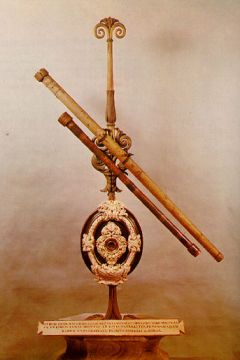THE ITALIAN RENAISSANCE ca. 1400 - 1600
Against a background of both political turmoil and intellectual achievement during the 15th century a surge of scientific and artistic activity emerged in Italy. Amid the ruins of Rome's classical architecture the inheritance of Western civilization was rediscovered. When the "New World" was discovered in 1492, Europeans eagerly sought to harvest the great reserve of natural resources found there.
|
|
Galileo's Astronomical Telescope

www.edinformatics.com
|
Scholarly advances, scientific discoveries, and daring exploration of distant places led to novel ideas about the cosmos.
The invention of printing (ca. 1455) allowed education to expand. The first universities were founded and the "rebirth" of learning that spread throughout Europe came to be known as the Renaissance.
A population that could now read the bible led to the Protestant Reformation (ca. 1517) and the once unified Christian world was split. The concept of the artistic genius evolved, especially with the appearance of such gifted individuals as Leonardo da Vinci (1452 - 1519) and Galileo (1564 - 1642).
The philosophy of humanism emerged along with a growing appreciation for the pleasures of everyday life. But the Church remained important in society.
|
|
While the rest of Europe lived under monarchs, the city-states of Italy had local rule in the person of an influential and powerful individual called the "Doge." Some merchants began to acquired large fortunes and huge estates that paved the way to political power. According to historian Richard Hooker:
"At the beginning of the high middle ages, wealth in Italy consisted almost entirely of land and was concentrated in the hands of the nobility. Through the development of commercial interests, wealth began to concentrate in the hands of the non-aristocratic peoples. Because the nobility tended to borrow money only to do non-productive things like gamble, party, and fight wars, they often defaulted on their loans. When they did, part of their property would transfer to the wealthy bankers and merchants. By the end of the fifteenth century, most of the wealth of Italy had been transferred away from the nobility, including the pope in Rome, to this new, commercial class." http://www.wsu.edu:8080/~dee/REN/BACK.HTM
|
return to top | next page